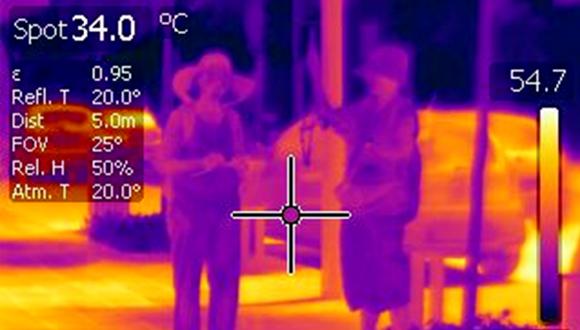דוקטורנטים מספרים - Inbal Gadish
Thermal Comfort Conditions in Public Spaces of a Densifying Urban Business District
Inbal Gadish
Supervisors: Prof. Hadas Saaroni and Prof. David Pearlmutter
This thermal photograph was taken by my supervisor, Prof. David Pearlmutter of Ben Gurion University, as part of evaluating street surface temperature. It illustrates thermal tension between urban surroundings and humans – in this case, my advisor Prof. Hadas Saaroni of the Tel Aviv University, and me.
Global warming, extreme population growth, and accelerated urbanization have made urban climate a hot research topic in recent decades. Outdoor thermal comfort is an essential aspect of this research field. Thermal comfort (TC) is determined both by meteorological variables – solar radiation, air temperature, relative humidity and wind speed – and by personal characteristics. TC is widely investigated around the world. So far, more than 200 models and indices have been developed for evaluating outdoor TC.
As a veteran architect who serves in the capacity of a regional planner in the Ramat-Gan municipality, I am involved in a promoted master plan for the already intensive business district of this city, Ha-Bursa. This plan would permit construction to extreme, unprecedented levels in Israel and also worldwide, in terms of rates of construction and building heights; it also visualizes the district as a vibrant urban center of commerce, recreation and culture. Densifying an already-built area is necessary for urban, infrastructural, economic, social and political goals; it is also most desirable as a means for saving land and minimizing the loss of natural open areas, which has been increasing at an alarming pace in Israel and many other countries. My research originated from the desire to understand the influence of raising and densifying buildings on TC conditions in the public spaces. We deal with a business district in the hot summer season of the Mediterranean climate, and to the best of my knowledge, a similar combination has not been investigated before. Since the balance between the meteorological parameters influencing TC differs by time and place, we could not determine in advance what would dominate – deep shading by high buildings (which improves TC) or wind speed attenuation for the same reason (which deteriorates it).
The present study quantifies the existing TC conditions in an intensive business district and evaluates the probable changes that may be expected due to an extreme heightening process. On the basis of field measurements (see the photo above) and data from Israel Meteorological Service (IMS), we used the Index of Thermal Stress (ITS) for these evaluations, through numerous sensitivity tests. Finally, we examined approaches to reduce anticipated thermal stress.
I hope that this work will inspire awareness to thermal considerations through planning among decision makers, since proper TC conditions are vital to a thriving and vibrant urban life.
Note: This study is supported by the Eda and Shlomo Zalman Najman fund for research on Climate Change and Urban Sustainability.


